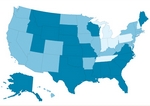government
Specialists push EPA for stronger air quality regulations
■ Doctors say revised ozone rules would improve respiratory health, but new standards have been delayed several times.
By Charles Fiegl — Posted Aug. 15, 2011
- WITH THIS STORY:
- » The dangers of ozone
- » Related content
Washington -- Physician specialty and public health organizations are urging the Obama administration to implement tougher air quality standards to improve respiratory health.
Fourteen associations, including the American Academy of Pediatrics and the American College of Preventive Medicine, wrote an Aug. 3 letter to the White House supporting new ozone air pollution standards. In January 2010, the Environmental Protection Agency proposed stricter ozone standards, but federal officials have delayed finalizing the regulation. Business leaders have opposed the rule by questioning the need for tighter pollution controls and citing the potential for higher costs associated with compliance in an already fragile economy.
The White House is reviewing the EPA rule. The agency wants to establish a stricter primary ozone standard of 60 parts per billion averaged over eight hours. The current standard is 75 parts per billion.
"A new ozone standard will be based on the best science and meet the obligation established under the Clean Air Act to protect the health of the American people," the EPA said on its website.
The EPA had said it would release the rule on July 29, but now the agency says it will finalize the ozone standard "soon." This marks the fourth time the regulation has been delayed, said Paul Billings, vice president of national policy and advocacy at the American Lung Assn.
Public health and physician associations said postponing the rule harms those with respiratory problems and delays pollution cleanup. This summer has had a high number of code orange and red days, which signify that levels of ozone and smog make breathing difficult.
"Breathing unhealthy levels of smog sends people to the hospital and emergency rooms and creates serious health risks," the letter to the White House states.
Ozone causes a chemical burn that injures the lungs when inhaled, said Jerome Paulson, MD, medical director for the Mid-Atlantic Center for Children's Health and the Environment in Washington. Ozone also makes the health of those with preexisting lung diseases worse. For instance, a child with asthma is more likely to wheeze when ozone levels are high.
The tougher standards would improve the health of Americans, especially children, said Dr. Paulson, who also chairs the American Academy of Pediatrics council on environmental health. Children breathe more air per unit of body weight and can be exposed to a higher dose of contaminants than adults, he said. Most health experts encourage kids to be outside playing and exercising, but breathing contaminated air will damage their lungs.
"We need to make sure they have clean air to breathe," Dr. Paulson said.
The business community has fought against implementing the standards. Stricter pollution controls would require firms to make environmental improvements to factories.
Annual attainment costs to businesses are estimated to be $1 trillion by 2020, according to a 2010 study by the Manufacturers Alliance. The U.S. Chamber of Commerce warned that there would be severe economic consequences from finalizing the proposed regulation.
"Implementing these new standards would start a domino effect for the vast majority of counties across the country that would become noncompliant," said Bill Kovacs, a senior vice president at the U.S. Chamber of Commerce.
A July report prepared for the American Petroleum Institute disputes EPA findings on the potential benefits of the rule from reducing exposure to ozone.
"If based on ozone benefits alone, not one of EPA's estimates of the benefits of reducing ozone to a tighter alternative ozone standard is as large as the costs of attaining that respective ozone standard -- all cost more than the ozone benefits they might provide," the report states.












